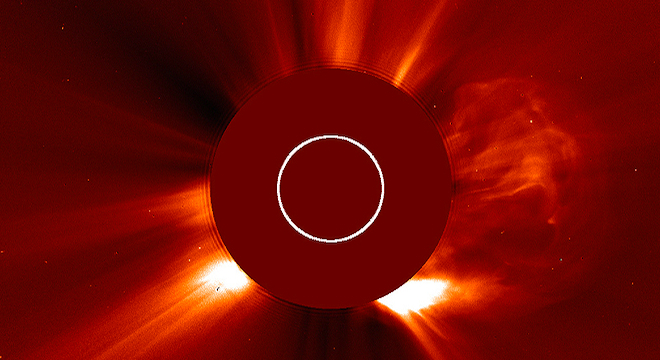The Sun may look like a smooth glowing ball from Earth, but its surface is constantly active, erupting with flares and streams of charged, radioactive particles called “coronal mass ejections,” or CMEs, which can have a profound impact on space weather.
As it turns out, NASA scientists just observed what is likely to be the fastest CME ever recorded, one moving away from the Sun at a speed of between 1,800 miles-per-second and 2,200 miles-per-second, which was captured by two Sun-orbiting satellites on July 23.
“Between 1,800 and 2,200 miles per second puts it without question as one of the top five CMEs ever measured by any spacecraft,” said solar scientist Alex Young at NASA’s Goddard Space Flight Center in Greenbelt, Maryland, in a NASA news release. “And if it’s at the top of that velocity range it’s probably the fastest.”
Check out a video of the ultrafast CME as seen from NASA’s STEREO-A spacecraft:
“It is visible light, so if our eyes were sensitive enough, we could see these features, just as we do during total solar eclipses here on earth,” said Joseph Gurman, a project scientist with NASA’s STEREO mission, in an email to TPM.
Further, the CME, which doesn’t have a name (it’s not NASA convention to name CMEs) — was exceptionally strong and wide, according to measurements taken by the NASA STEREO-A satellite. The CME was also observed by the NASA/European Space Agency Solar and Heliospheric Observatory (SOHO) satellite, which provided the view of the image at the top of this article.
Fortunately, the quick CME erupted from the side of the Sun facing away from Earth, so the CME did not strike our home planet. If it had, it could have caused a massive geomagnetic storm in the upper atmosphere, potentially disrupting radio communications, GPS, and even overloading the power grid in some places.
“Even though this CME is a surprising 135 degrees wide, that extent does not include the Earth,” Gurman explained to TPM.
“In fact most of the CMEs do not hit the Earth,” added NASA Goddard scientist Antti Pulkkinen, “The direction and the size of the CME needs to be in the ‘sweet spot’ in order to have an impact on the Earth.”
CMEs often occur at the same time or shortly before or after solar flares — sudden brightening in select regions of the Sun and eruptions of solar material, but not always. In this case, scientists aren’t sure whether a solar flare accompanied this CME.
“We don’t know!” admitted Gurman. “Simply because the event originated in an active region on the far side of the Sun, that is, the side not visible from the earth, we had no soft X-ray monitors.”
The video of the CME included above was a time-lapse put together from images taken over the course of nine hours.
Still, NASA scientists hope that they can use this particularly speedy CME to learn more about how the Sun impacts space weather throughout the solar system.
“It doesn’t matter if you fly cargo aircraft over the poles or are trying to figure out how to help astronauts survive trips to asteroids or Mars, you need to know when space weather will affect your electronic systems, and whether it threatens human safety,” Gurman told TPM, “There are direct, economic losses associated with space weather (re-routing polar aircraft routes costs more in fuel/less cargo, corrosion of pipelines, &c.) and the better we can characterize space weather cause and human-built systems effects, the better chance we have of mitigating the effects.”
The chance of a disruptive solar flare and CME striking Earth is only set to increase over the next year into 2013 as the Sun approaches “solar maximum,” the period where its most active, based on the recurring 11 year solar cycle.






